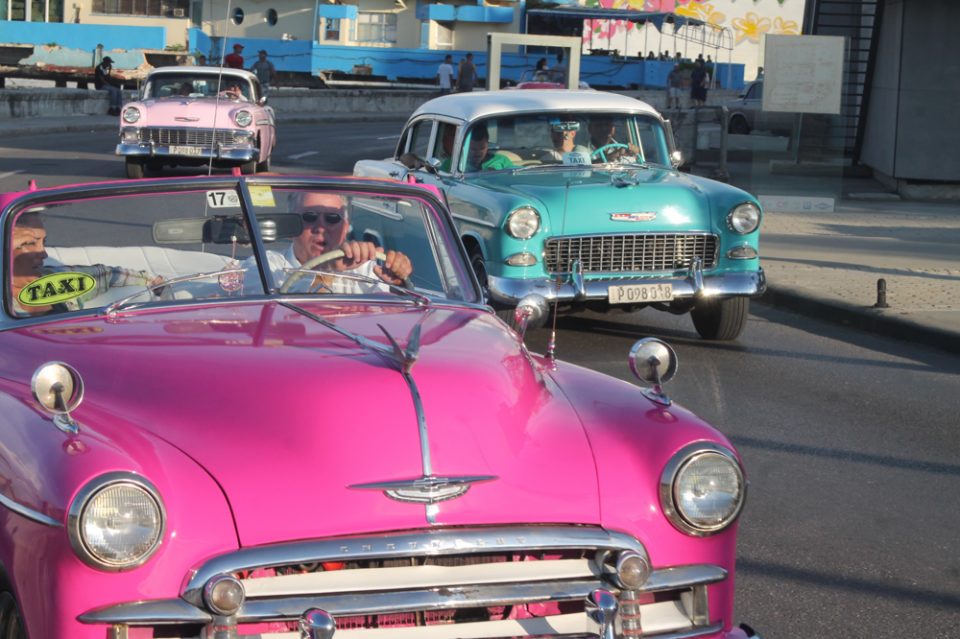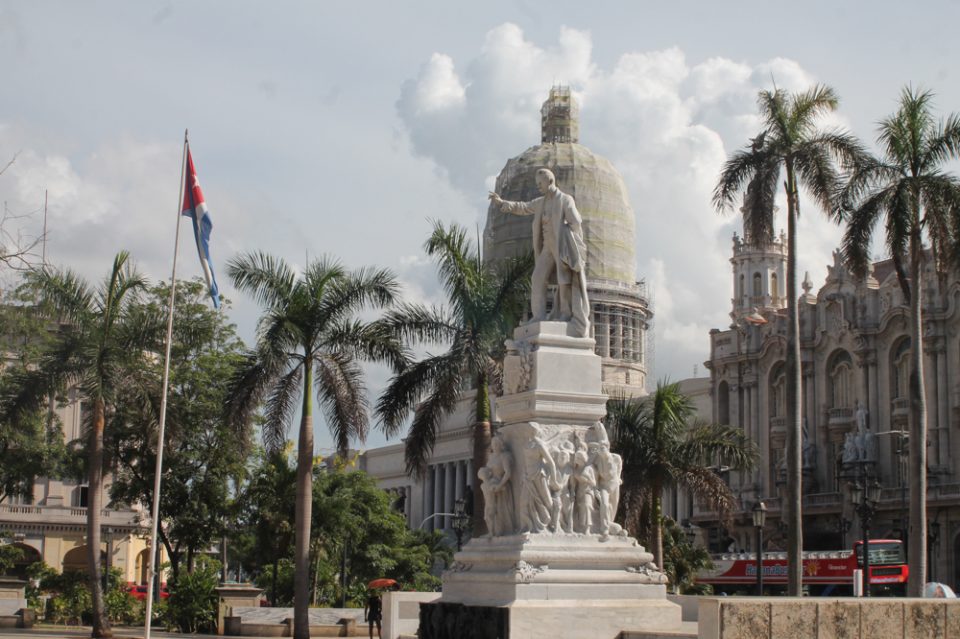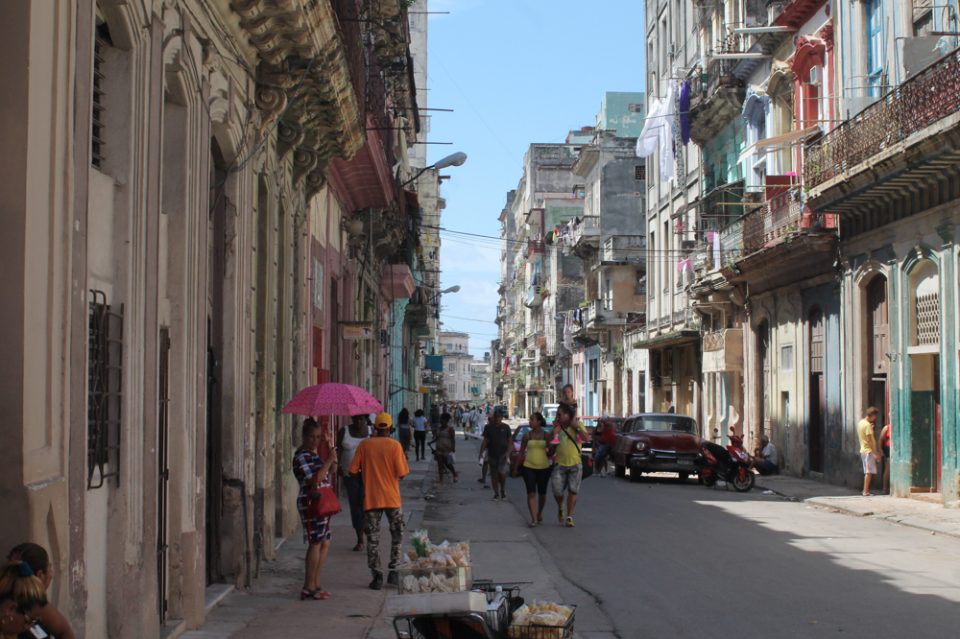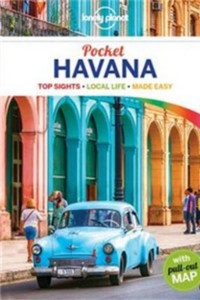Arriving in Havana, What to Expect & How to Prepare
Published by CamDarling on
Traveling Cuba was one of the most interesting experiences I’ve had to date. But it was also one of the most challenging countries to travel. Compared to China, Thailand or even Cambodia, Cuba is like taking a step back in time. There is limited tourist infrastructure like bus companies and hostels. Say goodbye to Wi-Fi for your entire stay, getting access is so difficult and unreliable, I recommend preparing everything from researching bus tickets, booking Airbnbs and tours in advance so that you can avoid having to use internet at all. Don’t even try to roam on your phone, it’ll cost you a fortune. Leave your phone on airplane mode the entire time.
When I arrived at Jose Marti International Airport at 2 am from Toronto, it was a mess. Just a free-for-all of locals in the lobby trying to sell rides into town and even accommodations for what was left of the night! I usually start writing a Travel Basics Page after I’ve written quite a few articles for a country, but my experience arriving in Cuba was unusually rough. There are a number of things I need to cover right away! From getting CUCs, to just getting a ride out of the airport to your casa or hotel in Havana. Not having access to internet is also a huge burden for using map and translation apps, communicating with other travelers, or even your own travel companion. Preparation and knowing what to expect is really important for traveling Cuba.
Traveling Cuba Solo vs. as a Duo
Cuba is a vacation destination for a lot of Spanish speaking South Americans. but also for Canadians to get away from the harsh winters. The trade and travel bans from the US has limited Americans from traveling to Cuba in real numbers. That policy has limited Cuba’s economy severely, but it has also preserved the raw cultural experience of Cuba which makes it such a unique country to travel.
I met many solo travelers in Cuba, but I have to say it doesn’t have the solo backpacker vibe of Thailand, Vietnam or Bali. Most of the accommodations are set up for pairs or families, there are few hostels where you can just book a single bunk. Meeting other solo travelers can be difficult, keeping in touch while you move from town to town, or simply meeting for drinks is almost impossible due to the limited internet access and expensive roaming cost. As an experienced solo traveler, I’m used to meeting others around the hostel bar, getting a good vibe going and pairing up the next day for a tour, or meeting up for some drinks. I do my thing, they do theirs but we can meet up later, or even in another town in a few days. This requires communication, which isn’t possible in Cuba.

If you are traveling with someone or in a group, you are stuck together for the entire trip. I wouldn’t split up and try and meet up again in a few days. You have to make plans to meet at a specific place at a specific time if you separate to do your own thing for a day, or even a few hours.
Alisa and I planned to travel Cuba together as a pair. She flew in from Belgium and I arrived from Canada. Right from the start we had trouble because my flight was delayed 3 hours and Alisa had no idea because there is no way to check flights without internet. I arrived at our Casa at 3 am and couldn’t even communicate standing outside the front door. Luckily the casa owner knew I was coming and stayed nearby to answer the door to let me in despite the late hour. In hindsight, a simple kids walkie talkie would have been amazing to have with me. It would have given us so much more flexibility and a 3 km radius to keep in touch.
For my young readers, a walkie talkie uses radio signals, so they don’t require internet or data. You simply have to set matching frequencies (Channel 1, 2, 3 etc..).
Arriving at Jose Marti International Airport
My chaotic arrival at Jose Marti International Airport is why I feel I must write this article. It was a fucking mess and I’ve never seen anything like it at any airport in any country in the world.
Here is the root of the problem: Cuban citizens are not allowed to travel internationally without government approval. If that seems insane, it’s because it is. Very few Cubans get approval to travel outside the country, so international airport services are essentially only for tourists. Jose Marti Airport is smaller than a rural Canadian Airport despite being the only international airport in a country with 11 million people. Cuban planes are also very old, fair warning.
My delay was because of Toronto’s Pearson International Airport which is one of the only airports with international flights to Cuba due to the US trade embargo. A new friend, Clem, from South Korea and the guy who sat beside on my flight, from Germany, both had to connect through Toronto, Canada. When I arrived I went through security just fine, waited in line for my passport stamp, and exited to the main lobby. I didn’t have check luggage, which really saved my ass. I only had two carry on bags and skipped the baggage claim.

It was 2 am at this point, I had been up for 23 hours straight. I was essentially first out of the plane to the lobby. I went immediately to the ATM and took out Cuban Convertible Pesos (CUCs), details below. The ATM had two security guards protecting it. Let that sink in. I waited in the lobby for the other tourists whom I agreed to share a Taxi with into Havana. While I was waiting, the security guards, clearly tired from a long day, shut down the ATM and locked it away. 100+ people waiting for luggage had yet to enter the lobby and use the ATM. They couldn’t get any local currency!
Luckily I got some Pesos. The lobby was a free-for-all of drivers, licenced or not didn’t seem to matter much. There were a few of the old 1960s cars in the parking lot, but those usually cost quite a bit more for a ride and it was past 2 am. So we looked for a regular Yellow Taxi. I covered another traveler’s share of the Taxi in Pesos in return for Canadian Dollars. But how does a country’s main airport not have any ATMs open while there are still tourists getting their bags? Crazy.

Taxis to Downtown Havana
Once my party of three was ready to leave the airport, the only option for us was taking a cab since neither of us had pre-arranged a pick-up or had a chartered bus which is sometimes included in vacation packages at big resorts.
There seems to be some kind of queue system for Taxis but they couldn’t decide who was taking us into town. They charged us 30 CUC, a premium over the usual 20-25 CUC ($20-25 USD) because we were three people with two drop off locations in downtown, and probably because of the late hour. That’s fine. At least I had money to pay for the Taxi. Some people would’ve had to use a foreign currency.
Our driver was a nice young guy who didn’t really speak any English. But he did laugh at my inappropriate jokes in Spanish. He used a GPS to load the addresses we had for our hostels or Casas. I recommend writing the address of your accommodation in Spanish, on paper, and keeping it in your money belt or purse. There were very few cars on the road at 2:30 am, so we zoomed around town really quickly which was nice. Little did we know that the roads in Cuba are always kind of empty of cars.
There are bus services in Cuba, but for whatever reason they decided not to have any running between downtown and the airport. Taxis have a complete monopoly at the airport. There is a Viasul Bus Terminal 15 Kms away, which is the best option for those headed towards Varadero directly who don’t already have pre-arranged pick up.
Booking an Airbnb in Advance
Cuba has thousands of family owned Casas that rent out rooms by the night like Airbnb. Casas range from $10 USD per night to $25 USD per night.
I can’t be more explicit: Book something in advance for least the first night or two and see if they can arrange a pick up at the airport for you. That’ll save you a lot of trouble, especially if you prepay for the ride. If you read the next section about Pesos and ATMs you’ll understand why.
Although internet access is difficult to get in Cuba, the local Cubans can respond to Airbnb messages and bookings using SMS on their phones. Great article on how Airbnb made it so easy for locals, they essentially dominate the bookings market in Cuba.
Booking on the go isn’t easy. You either need a casual itinerary and plan to arrive in each new town during mid-day to have time to find a casa in person, or what I recommend: Book all your airbnbs before you go. Save yourself the trouble.
Some of the buildings in Havana are in rough shape. I have an entire article planned on the history of Havana and architecture, but for booking Airbnbs… Choose one within walking distance to where you want to visit. The streets may look rough, but the actual Casas are pretty nice inside!
The Cuban Convertible Peso (CUC)
There are many things about currency in Cuba that I read online while preparing for the trip. It was hard to know what was true and what was bullshit. Other bloggers and backpackers have covered this problem, some much better than others. But currency is my thing, I work in financial services, I collect coins from countries around the world. I got this!
Actually being in Cuba and experiencing it first hand is a whole other beast. I can see how the two pesos can be confusing because they are both called PESOS!
CUCs say “Convertible Peso” on the bills and 1 CUC is worth $1 USD.
There are CUC coins, like a $0.25 CUC coin below that are circulated around Cuba. But most places will give you local pesos for amounts under 1 CUC. For example, a meal is 4.50 CUC ($4.50 USD) and you give them a 5 CUC bill. They will give you 0.5 CUC in either CUC coins or 12 CUPs (local pesos)
Local bills also have the same numbers but don’t say convertible peso. They are worth way less! 1 CUP is like $0.05 USD. CUP coins are essentially worthless. I found some dating back to the 1960s. I asked my host, Lionel, if I could have them and he said they were useless. I started picking up all the old coins out of the dirt.
CUCs - 5 Things You Should Know
I used the ATMs with my credit cards from Canada without a problem but I also visited a few banks to convert Canadian Dollars into convertible pesos and local pesos too. So here is what you need to know about Cuban Pesos, Banks and ATMs and preparation tips.
- There are two kinds of currency in Cuba. The Convertible Peso (CUC) and local Peso (CUP). 1 CUC is roughly $1 USD, but 1 CUC is roughly 20-24 CUP. All the major tourist spots accept the CUC from tourists but a few local shops like the pizza and little hole in the wall burger will take CUPs. You can exchange CUCs for CUPs at any bank, bring your passport. This is worth it because you’ll often get local prices, in local currency!
- You Cannot Get CUCs Before Arrival. It’s just not possible from any bank.
- As a Canadian I often carry US Dollars when I don’t have the local currency, or even for emergencies. US DOLLARS ARE EXTREMELY BAD IN CUBA. Americans, take warning and exchange your USD for Euros or preferably Canadian Dollars because of point 5 below. The banks, agencies, hotels, will gouge anyone trying to convert USD to CUCs. It’s way more expensive coming in with US dollars, literally any other currency is better.
- ATMs are not reliable. They are often out of funds, or reject credit cards. Many prepaid credit cards do not work at all in Cuba. Carry multiple credit card types (Visa, Mastercard). American Express is not accepted in most ATMs. I would carry a large amount of Euros or Canadian Dollars and exchange them directly for CUCs at any local bank when they are open (9am-5pm). There is no ATM risk that way.
- Banks won’t accept slightly ripped money. It’s dumb, I know. If you have the choice between carrying Euros or Canadian Dollars as backup funds, pick newly minted Canadian Bills. They are made from a polymer-plastic and can’t rip. Euros still use cotton bills, if you happen to rip it in your bags, it’s useless in Cuba.
Spanish Phrasebook & Cuba Guidebook
If you ask Alisa, she will tell you that I was glued to my Lonely Planet Cuba guidebook. I read it on the buses, in the taxi-camiones rides, before bed and during breakfast. I went through that book from front to back.
It was totally worth bringing a Guidebook and a Spanish Phrasebook. We didn’t plan our trip in advance other than our first few days in Havana. So we had to decide which cities to visit and in what order on the go. Using the guidebook, we decided to visit Varadaro, then Trinidad and Vinales, finishing our trip back in Havana for two days.
For us, less was more. We stayed for 3 days in each town and enjoyed the slower pace of travel. That mean’t we didn’t get to see some of the other popular cities like Santa Clara, Cienfuegos, Pinar del Rio or Mantanzas. But we also didn’t waste every other day traveling from one town to another. Some of these bus rides are 6-8 hours long.
Neither Alisa or I speak fluent Spanish. We speak 7 languages between the two of us, but none of them are Spanish. French was the closest we had, so having a phrasebook was very useful. English isn’t common in Cuba. Even our Casas we found on Airbnb were hit and miss with English. The younger the casa owner, 20s or 30s, the better their English. Having a casa owner who spoke English was an enormous benefit! Helping with tours, restaurant recommendations, buses, taxis etc… We didn’t really rely on a guidebook for tours or restaurants, simply because they can be a little outdated. Asking for recommendations from the Casa owners is really the best way to go!
Again, there is no internet access in Cuba. You need to download the language package in Google translate for Spanish if you want to use the app. Even then, the offline function of translations apps are usually limited. Having a book is so much easier!
If you take a look at our App articles, I almost always recommend a free language phrasebook app, or free dictionary. I love free stuff, but picking up a Spanish book was so worth it. I also brought a Spanish Idioms Handbook which was quite fun, I practiced using Spanish expressions. That’s obviously not necessary for travel. There are kindle versions for cheap too for both the guidebooks and phrasebooks.
Offline Apps & Maps
Due to the limited internet access in Cuba, tourists often do not have the apps and maps we have grown to rely on while traveling abroad. At least in other countries you can preload Google Maps with hostel Wi-Fi then head out for a day with your directions in hand, but in Cuba that’s not possible. There is no Wi-Fi at most hostels (even if it says so on the booking, it’s probably a lie). There are very few hotels with Wi-Fi, let alone lower cost accommodations like hostels and Casas.
I recommend downloading Maps.me for your offline map. GPS still works, you just need to have the maps downloaded to your phone. Download the app, open it up and search for Cuba. You’ll get a pop-up when you zoom in over Cuba to download the map. Do it.
Most apps now require a constant data connection to work, or at least some internet access to load information. There are very few apps that work purely offline with their full capabilities. I listed a few to try in our Best Apps for Cuba article.
Another Android app to check out is Cuba Mobile Reference on the Amazon App Store.
Havana Photo Gallery
Both Alisa and I arrived very late at night, the next morning in Havana we both experienced a culture shock while exploring the streets. We asked ourselves “Are we in a bad part of town?” the streets were more than little rough as there was construction supplies, carts and debris just sitting on the sidewalks. It turns out, that’s just Havana! Some areas are a little less maintained than others. We had heard about the condition of Havana, but seeing it was something else. There were trees growing out of abandoned buildings.
We slowly got used to the Havana experience throughout the first day and eventually we didn’t even notice it at all. We stayed in the area along the boardwalk “Malecon” (left photo street above), a 20-25 minute walk from the El Capitolio and Central Park. The street clutter slowly improved as we made our way east towards the old cobblestone quarter of the city (right photo street above).
Disclaimer: Amazon is an affiliated partner, we make a small commission from bookings and purchases at no cost to you. It helps us publish more useful travel guides.
More Info for Travel to Cuba
I think of Cuba as one of the last remaining frontiers of the old world. From the classic cars, to colonial architecture and small local farms with horses and wagons… Cuba is this unique place frozen in time is some ways, while modern and hip in others. The best place to start your journey into the depth of Cuban history and travel is with these three articles:




























